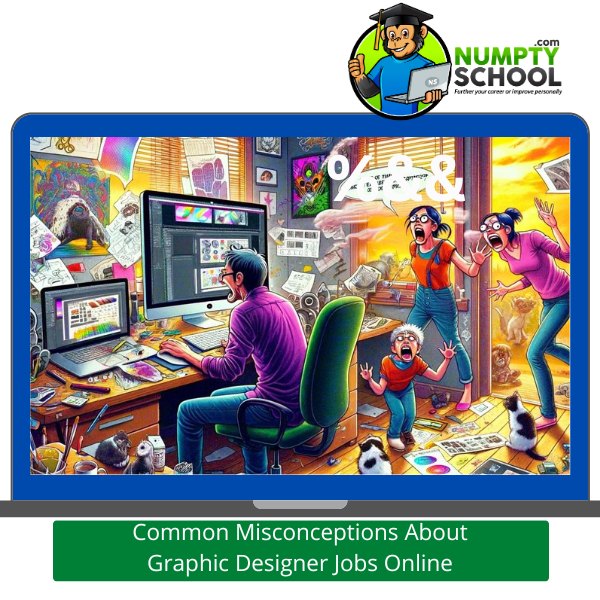Common Misconceptions About Graphic Designer Jobs Online

Introduction
Graphic design is more than just an aesthetic profession; it’s a critical component of business communication across the globe. As more organizations recognize the power of effective visual communication, the demand for graphic designers has expanded, particularly in the online space. Despite its growth, many misconceptions about online graphic design jobs persist, clouding perceptions and expectations. This article aims to clear the air by debunking these myths and shedding light on the realities of being an online graphic designer.
What is a Graphic Designer?
Graphic designers are visual communicators who create concepts by hand or using software to communicate ideas that inspire, inform, or captivate consumers. They develop the overall layout and production design for advertisements, brochures, magazines, corporate reports, and, increasingly, digital properties. As visual storytellers, they are pivotal in branding, making abstract concepts visually memorable and accessible.
Common Misconceptions
Misconception 1: Easy to Start
While graphic design tools have become more user-friendly and accessible, effectively launching a career in graphic design involves much more. Aspiring designers must not only master software but also understand fundamental design principles like color theory, typography, and user experience. Breaking into the field requires dedication, a strong portfolio, and often, professional connections that can take years to develop.
Misconception 2: Not Real Jobs
The gig economy and digital revolution have legitimized remote and freelance careers as viable and respectable. Online graphic designers often contribute to major projects for large corporations, startups, and everything in between, proving that these positions are as real and crucial as any traditional job.
Misconception 3: No Skills Needed
This myth undervalues the profession and the extensive training that successful designers undergo. Proficiency in design software like Adobe Creative Suite is just the beginning; top-notch designers are also adept in strategic thinking, problem-solving, and client communication, all of which are essential for delivering compelling visual solutions.
Misconception 4: Low Pay
While entry-level freelance gigs can start low, specializing in areas like UX/UI design, motion graphics, or digital marketing can significantly boost a graphic designer’s earning potential. As with many fields, building a reputation and demonstrating impact are key to advancing and increasing one’s earning potential.
Misconception 5: Limited Growth Opportunities
The digital nature of graphic design allows professionals to work with clients globally, providing endless opportunities for career growth and variety in work. Designers can advance to become art directors, brand managers, or start their own design agencies, all from a remote or online setting.
Impact of Misconceptions
These misconceptions can discourage talented individuals from entering the field and can skew client expectations about the time and skill required for design projects. Clarifying these points helps both designers and their clients set realistic goals and maintain productive relationships.
Real Challenges
Competition
The barrier to entry in online graphic design might be low, leading to significant competition. Designers must constantly innovate and market themselves effectively to stand out in a crowded marketplace.
Skill and Portfolio Development
The dynamic nature of graphic design requires continuous learning and adaptation. Designers must regularly update their portfolios to showcase their best and most relevant work, demonstrating their evolution and mastery of the field.
Client Management
Managing clients remotely requires exceptional communication skills and the ability to manage expectations around timelines, deliverables, and revisions. Successful online graphic designers excel in building trust and delivering consistent value.
Advantages of Online Graphic Design Jobs
Flexibility in location and hours makes online graphic design particularly appealing. Designers can choose to work with clients across different time zones, which can increase job opportunities and diversify their work experience.
How to Succeed in Online Graphic Design
Setup a Home Workstation
OK, the image shows a home in chaos, and in some cases that could be a true reflection of what happens. Our advice is to create a working environment where you can work calmly and quietly without too many distractions. That can be difficult in shared living spaces so maybe work around times when others are sleeping or out. Working remotely can usually mean working the hours that suit you so if you use them wisely you can provide good results. Even building a work shed in the yard can be a practical solution just remember to think about your needs, power, heat, and networking are absolute musts.
Continuous Learning
The best designers stay ahead of trends and technological advancements, continually refining their skills. Regularly attending workshops, obtaining certifications, and participating in design communities can contribute to a designer’s professional growth.
Networking
Effective networking in virtual settings through social media, professional platforms like LinkedIn, and participation in design forums can lead to new opportunities and collaborations, enhancing a designer’s visibility and credibility in the industry.
Conclusion
The path to becoming a successful online graphic designer is paved with challenges and opportunities. By debunking common misconceptions and embracing the realities of the profession, aspiring designers can better navigate their careers toward long-term success and fulfillment.
FAQs
Q) Is a degree necessary for a career in graphic design?
A) While not mandatory, a degree can provide a structured learning experience and credibility in the field.
Q) What are the best tools for a beginner graphic designer?
A) Beginners should start with Adobe Photoshop and Illustrator to build a solid foundation in design.
Q) How often should I update my design portfolio?
A) Update your portfolio at least once a year or whenever you complete a significant project.
Q) What is the average salary for an online graphic designer?
A) Salaries vary widely based on experience, specialization, and location but can range from $40,000 to over $100,000 annually for senior roles.
Q) How can I protect my work as a freelance designer?
A) Use contracts for every project, clearly defining scope, revisions, and copyright terms to protect your work and ensure clear agreements with clients.



